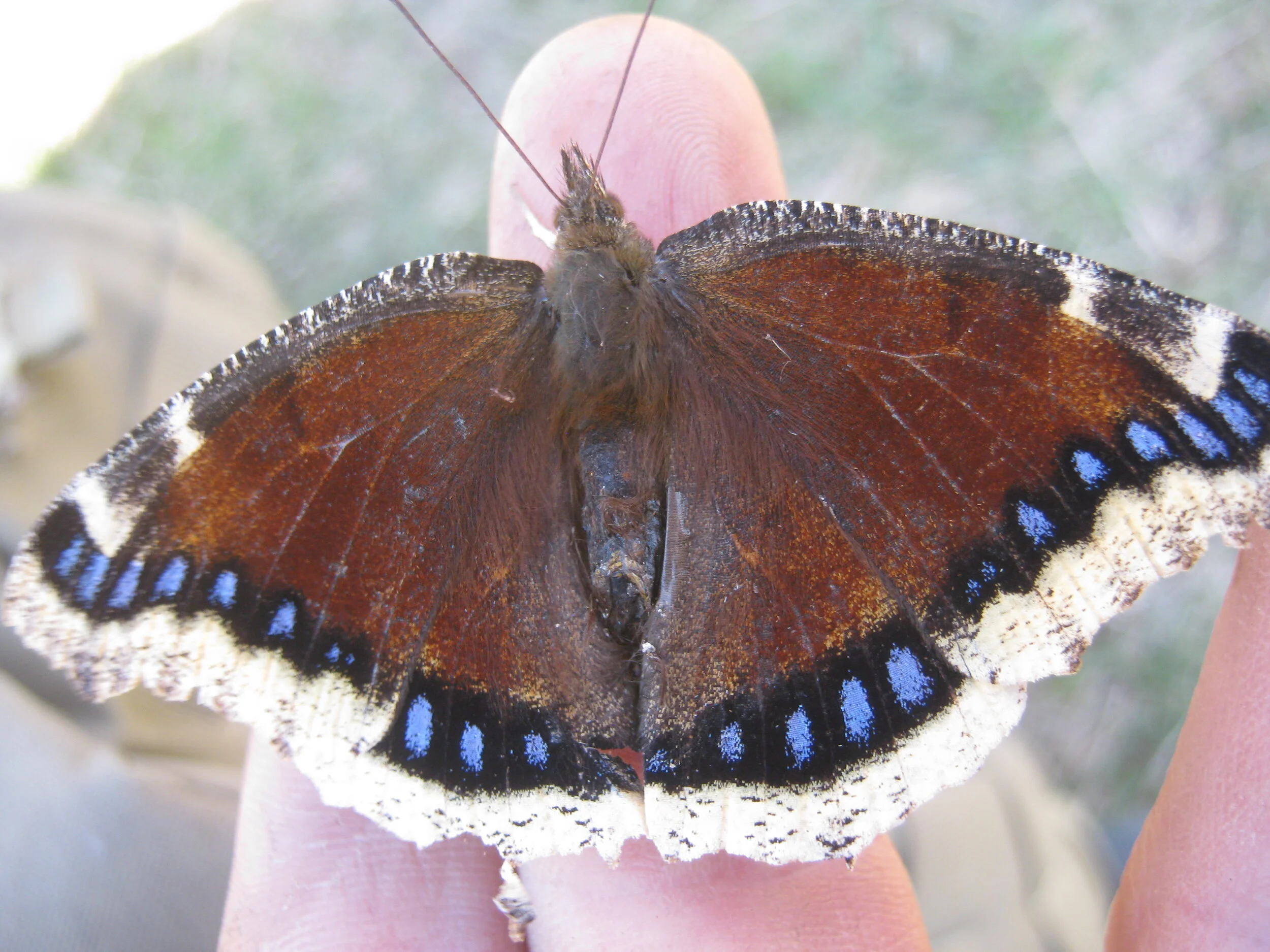The First Flutterby/Butterfly of the Year.
I once read somewhere that Butterflies used to be known as Flutterbys and this made a lot more sense to me. I appreciated the visual description which gave more detail and understand than Butterfly could. Was this historical name actually a common title? I am still unsure, but I try to use this title once in a while with my students so we can all understand and practice the transitory nature of names, language and our relationships with the landbase.
In the past couple of days we have seen quite a few Mourning Cloaks (Nymphalis antiopa) flitting along the tracks between the Pine (Pinus spp.) plantations at work.
A deceased Mourning Cloak, 22.09.2018 .
These awesome Brushfoots overwinter (hibernate) under bark on trees, cavities, in wood piles, tucked into these small tight places avoiding being covered in snow. There they sleep and wait until the spring when they emerge, triumphant over the cold. There colours are less mournful to me, but celebratory and exuberant, like the bird song in the mornings these days.
Mourning Cloak adults emerge at a time when there aren’t many flowers up producing nectar which they could be feeding on, so instead they eat decaying materials and animal scat. I had heard of this from my friend Tamara years ago, and then saw a Mourning Cloak land on a pile of Deer (Odocoileus virginianus) scat only a day or so later. It was fun to see this trait expressed just after hearing about it. Though this is common enough, they are more likely to be sustaining themselves in their adult foms (as Flutterbys) by consuming tree sap, from Maples (Acer spp.)and Birches (Betula spp.) or decaying fruits - perhaps those that had been frozen and now thawing?
I have read about territorial behaviours of the males (though females and males don’t look too different so I don’t know how folks can tell it’s just the males) where they fly at other Mourning Cloaks and try to push them out of their little perching territories where they display their beautiful colours trying to impress a mate. Once they find a female, and they have mated, the female Mourning Cloaks lay their 30-50 eggs in a mass encircling a twig of a variety of different species of trees including Elms (Ulmus spp.), Poplars (Populus spp.), Willows (Salix spp.), and Hackberry (Celtis spp.). After about one to two weeks, the young larval caterpillars, sometimes known as “Spiny Elm Caterpillar”, so named due to the long black spines along the length of their white speckled, red dorsal dotted bodies, emerge en masse and begin to feed. One source I read said they feed most of the spring and into the summer, while another just said 4 weeks, and they disperse from their food plant and find a new place to spin their silken chrysalis where the metamorphosis takes another 2 weeks. Once they emerge from the chrysalis as full blown Butterflies/Flutterbys, they then aestivate (like a hibernation induced by heat instead of cold) until the fall. When they wake from their summer siesta they find a spot hidden from Birds and other potential predators and take a long winters nap only to fly again in the early spring and repeat the cycle again.
These Flutterbys/Butterflies are considered the longest living Butterflies/Flutterbys in the Great Lakes Bioregion, likely due to all that aestivation and hibernation. When we see them emerge in the spring as we have recently at the school where I work, it is likely they have been around for 10 months or so, which really is a long time for an insect. Already I look to the Mourning Cloak as a symbol of spring, a warm welcome of the returning warmth, but now considering the details of the life cycle, and through taking the time to see a greater depth into their lives, I see the resilience of the species and have an even deeper appreciation.
Questions for the future:
How do researchers in the field discern the males from the females?
Is eating scat still called caprophagy when it’s an insect instead of a mammal (like a Rabbit) doing it or is there a different name?

